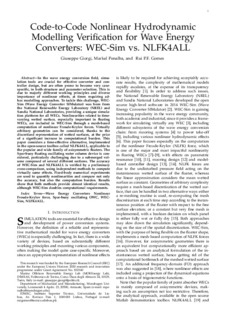| dc.contributor.author | Penalba, Markel | |
| dc.contributor.other | Giorgi, Giuseppe | |
| dc.contributor.other | Gomes, Rui P.F. | |
| dc.date.accessioned | 2022-11-11T15:56:27Z | |
| dc.date.available | 2022-11-11T15:56:27Z | |
| dc.date.issued | 2021 | |
| dc.identifier.issn | 2706-6940 | en |
| dc.identifier.other | https://katalogoa.mondragon.edu/janium-bin/janium_login_opac.pl?find&ficha_no=166834 | en |
| dc.identifier.uri | https://hdl.handle.net/20.500.11984/5844 | |
| dc.description.abstract | In the wave energy conversion field, simulation tools are crucial for effective converter and controller design, but are often prone to become very casespecific, in both structure and parameter selection. This is due to majorly different working principles and diverse importance of nonlinear effects, at times requiring adhoc modelling approaches. To tackle this challenge, WECSim (Wave Energy Converter SIMulator) was born from the National Renewable Energy Laboratory (NREL) and Sandia National Laboratories, providing a unique simulation platform for all WECs. Nonlinearities related to timevarying wetted surface, especially important in floating WECs, are included in WEC-Sim through a mesh-based computation of nonlinear Froude-Krylov forces. Virtually arbitrary geometries can be considered, thanks to the discretized representation of wetted surfaces, at the price of a significant increase in computational burden. This paper considers a time-effective alternative, implemented in the open-source toolbox called NLFK4ALL, applicable to the popular and wide family of axisymmetric floaters. The Spar-buoy floating oscillating water column device is considered, particularly challenging due to a submerged volume composed of several different sections. The accuracy of WEC-Sim and NLFK4ALL is verified by a preliminary cross-comparison, using independent methods to compute virtually same effects. Fixed-body numerical experiments are used to quantify nonlinearities and compare not only he accuracy, but also the computation burden. Results show that both methods provide almost identical results, although WEC-Sim doubles computational requirements. | en |
| dc.language.iso | eng | en |
| dc.publisher | EWTEC | en |
| dc.rights | © 2021 EWTEC | en |
| dc.subject | Wave energy converters | en |
| dc.subject | Nonlinear Froude-Krylov force | en |
| dc.subject | Spar-buoy oscillating | en |
| dc.title | Code-to-code nonlinear hydrodynamic modelling verification for wave energy converters: Wec-sim vs. nlfk4all | en |
| dc.type | http://purl.org/coar/resource_type/c_c94f | |
| dcterms.accessRights | http://purl.org/coar/access_right/c_abf2 | en |
| dcterms.source | Proceedings of the European Wave and Tidal Energy Conference | en |
| local.contributor.group | Mecánica de fluidos | es |
| local.description.peerreviewed | true | en |
| local.description.publicationfirstpage | 1971-1 | en |
| local.description.publicationlastpage | 1971-7 | en |
| local.contributor.otherinstitution | https://ror.org/00bgk9508 | es |
| local.contributor.otherinstitution | https://ror.org/01c27hj86 | es |
| oaire.format.mimetype | application/pdf | |
| oaire.file | $DSPACE\assetstore | |
| oaire.resourceType | http://purl.org/coar/resource_type/c_c94f | en |
| oaire.version | http://purl.org/coar/version/c_ab4af688f83e57aa | en |







